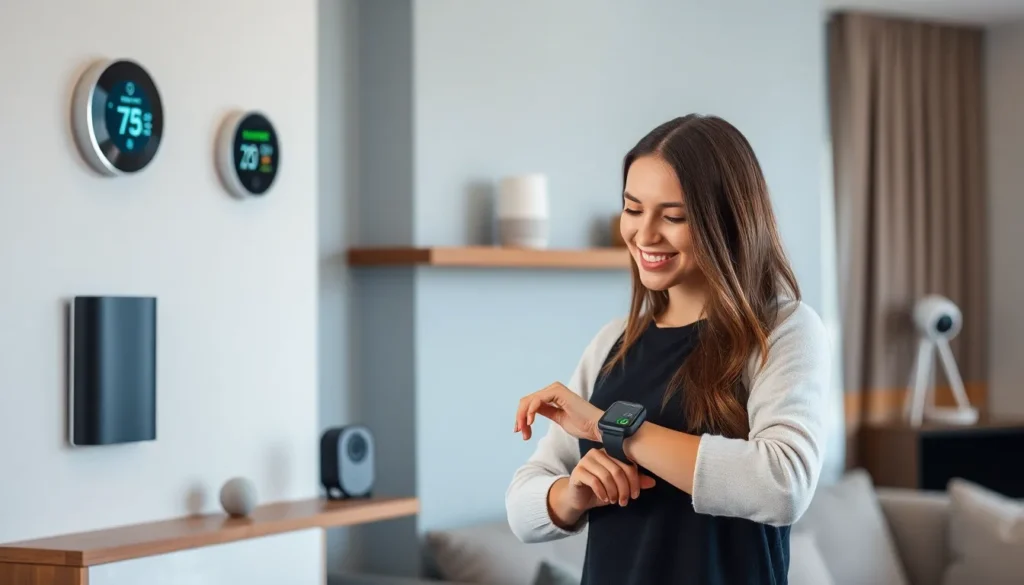In today’s fast-paced world, technology isn’t just a tool; it’s a vital part of everyday life. From smart homes to wearable devices, innovations are reshaping how people live, work, and connect. As technology continues to evolve, it influences everything from personal health to social interactions, making life more convenient yet complex.
This intersection of technology and lifestyle presents both opportunities and challenges. While advancements offer unparalleled access to information and convenience, they also raise questions about privacy and mental well-being. Understanding this dynamic relationship is essential for navigating the modern landscape and making informed choices that enhance quality of life.
Table of Contents
ToggleOverview of Technology and Lifestyle
Technology shapes lifestyle in numerous ways, influencing how individuals communicate, work, and manage daily tasks. Smartphones, the internet, and wearable devices change personal interactions, providing instant access to information and enhancing connectivity.
Impact on Personal Health
Technology offers tools that track fitness, monitor health conditions, and promote well-being. Wearable devices, such as smartwatches, provide real-time data on physical activity, heart rate, and sleep quality. Apps encourage healthier choices by connecting users with nutrition information and exercise recommendations.
Influence on Social Interactions
Social media platforms foster connections among friends, family, and colleagues. Users share experiences, receive support, and communicate across distances. Yet, these platforms can also lead to superficial relationships and impact mental health negatively, illustrating the dual effects of technology on social dynamics.
Convenience in Daily Life
Smart home technologies streamline household management through automation. Devices like smart thermostats, lights, and security systems enhance convenience and energy efficiency. Online shopping and banking offer time-saving solutions that simplify everyday tasks, contributing to overall lifestyle improvements.
Challenges in Privacy and Mental Well-Being
Technology’s advancements raise concerns regarding data privacy and mental health. Increased digital surveillance and the collection of personal data necessitate vigilance. Furthermore, excessive screen time correlates with anxiety and sleep disturbances, prompting users to balance digital engagement with offline activities.
Navigating the Technology-Lifestyle Relationship
Understanding technology’s role in shaping lifestyle involves recognizing both benefits and challenges. Making informed decisions about the use of technology can enhance quality of life while mitigating potential adverse effects on health and relationships. Embracing a balanced approach empowers individuals to thrive in the digital age.
Impact of Technology on Daily Life

Technology significantly influences daily life, enhancing convenience, efficiency, and connectivity. Advancements in smart home solutions and wearable devices play key roles in transforming how individuals manage their routines and health.
Smart Homes and Automation
Smart home technology automates household functions, improving daily efficiency. Devices such as smart thermostats, security systems, and smart appliances enable remote control and automation, reducing energy costs and increasing security. For instance, smart thermostats like Nest optimize heating and cooling based on user habits, leading to energy savings of up to 15% annually.
Automation tools enhance home security with features like real-time monitoring and alerts. Smart cameras offer live feeds and notifications, allowing homeowners to monitor their properties from anywhere. Additionally, voice-activated assistants, such as Amazon Alexa and Google Assistant, streamline home management by enabling users to control devices through voice commands, creating a more integrated living environment.
Wearable Technology
Wearable technology significantly impacts personal health management, providing real-time health data. Devices such as fitness trackers and smartwatches monitor metrics including heart rate, calorie consumption, and sleep patterns. For example, Fitbit and Apple Watch offer insights into physical activity, encouraging users to reach fitness goals.
Health monitoring capabilities extend to chronic condition management. Wearables integrated with health applications provide alerts for medication and track vital signs, facilitating better medical oversight. Studies indicate that individuals using wearable technology experience increased awareness of health habits and make positive lifestyle changes.
Wearable devices also enhance social connectivity through features that allow for communication and notifications. Users can receive messages and calls directly on their devices, reducing the need for frequent phone checks and fostering a more streamlined communication process.
Technology in Health and Wellness
Technology plays a vital role in enhancing health and wellness, offering innovative solutions that empower individuals to take charge of their well-being.
Fitness Trackers and Apps
Fitness trackers and apps provide users with real-time insights into their health metrics. These devices monitor physical activity, heart rate, sleep patterns, and more, creating comprehensive health profiles. Popular options like Fitbit and Apple Watch integrate with mobile applications, allowing users to set goals and track progress effectively. Users can also access nutrition tracking apps such as MyFitnessPal, which help them monitor dietary habits and make healthier choices. By providing instant feedback and encouraging accountability, these tools promote sustainable lifestyle changes and improved fitness levels.
Telemedicine and Virtual Care
Telemedicine transforms access to healthcare services, enabling remote consultations between patients and healthcare providers. Platforms like Teladoc and Amwell facilitate video appointments, mitigating barriers related to distance and availability. Patients can receive diagnosis, treatment plans, and prescriptions without visiting a physical office. This convenience reduces waiting times and enables individuals to manage their health more effectively. Virtual care supports continuous monitoring of chronic conditions, allowing doctors to adjust treatment plans promptly. The integration of telemedicine within the healthcare ecosystem enhances patient engagement and promotes preventive care.
The Role of Social Media
Social media significantly impacts social interactions and lifestyle choices. Platforms facilitate connections but also present challenges for mental well-being.
Connection and Communication
Social media enhances online communication across diverse platforms. Users engage with friends and family through apps like Facebook, Instagram, and Twitter, fostering immediate interaction. Groups and communities form based on shared interests, enabling friendships that might not arise in traditional settings. Instant messaging and video calls improve real-time communication, bridging geographical gaps.
Social media facilitates networking opportunities for professionals. Platforms like LinkedIn aid in career advancement, allowing users to connect with industry peers and potential employers. This virtual networking fosters professional growth and knowledge sharing, enriching both personal and professional lives.
Influences on Lifestyle Choices
Social media influences lifestyle choices through content sharing and exposure. Influencers promote products and lifestyles, shaping consumer habits and trends. Users often seek validation through likes and shares, impacting their preferences and purchasing decisions. This phenomenon drives the popularity of health, fitness, and wellness trends, which gain traction through viral content.
Social media acts as a platform for awareness, with campaigns tackling social issues and promoting healthy living. Users encounter motivational content, which encourages lifestyle changes such as adopting healthier diets or engaging in regular exercise. This influence extends beyond individual behavior, creating a collective shift towards more conscious living practices among users.
Future Trends in Technology and Lifestyle
Future trends indicate a significant evolution in how technology continues to integrate with daily living. Emerging technologies and sustainability-focused innovations shape lifestyle choices and consumer behavior.
Emerging Technologies
Emerging technologies like artificial intelligence (AI), augmented reality (AR), and the Internet of Things (IoT) redefine personal and professional interactions. AI personal assistants streamline daily tasks by managing schedules and providing recommendations. AR applications introduce immersive experiences in education and entertainment, enhancing user engagement through interactive content. IoT devices foster connectivity across home ecosystems, enabling seamless communication between appliances, ultimately improving convenience.
Smart cities leverage these technologies for enhanced urban living. By utilizing data and connectivity, cities optimize public services, reduce traffic congestion, and promote energy efficiency. Autonomous vehicles represent another pivotal advancement, promising to transform transportation by improving safety and reducing emissions. Collectively, these trends enhance productivity while tailoring lifestyle experiences to individual preferences.
Sustainability and Eco-Friendly Innovations
Sustainability and eco-friendly innovations play a crucial role in future technology trends. Green technologies focus on reducing environmental footprints through energy-efficient solutions. Renewable energy sources, such as solar and wind power, gain traction in residential and commercial applications, decreasing reliance on fossil fuels.
Smart home devices optimize energy consumption through intelligent management of resources, helping users track and reduce their utility usage. Innovations in sustainable materials, such as biodegradable plastics and recycled aggregates, influence product design and manufacturing processes, encouraging eco-conscious consumption.
Moreover, technology promotes awareness of environmental issues through platforms that facilitate knowledge sharing and community engagement. These advancements reflect a shift toward more responsible lifestyles, combining convenience with a commitment to environmental stewardship.
Technology’s influence on lifestyle is both profound and multifaceted. As individuals navigate the digital landscape they must balance the conveniences offered by advancements with the challenges that arise. Embracing tools like wearables and smart home devices can enhance daily living while promoting health and efficiency.
However it’s crucial to remain mindful of privacy concerns and the potential impact on mental well-being. The future promises even greater integration of technology into everyday life with innovations that prioritize sustainability and responsible consumption. By making informed choices individuals can harness the benefits of technology while fostering a lifestyle that supports overall well-being.









